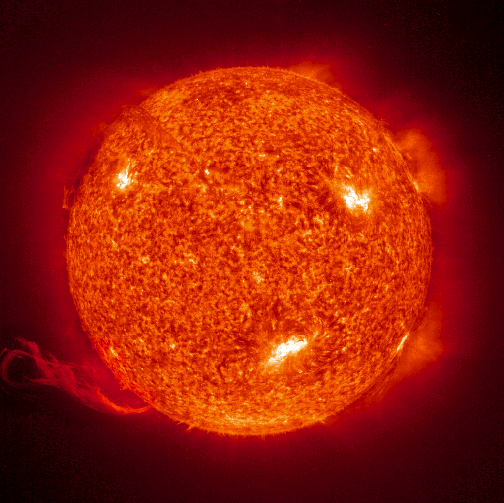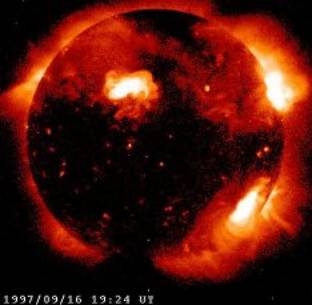
In 1610, as soon as Galileo constructed his new scientific apparatus, telescope, he pointed it to the sky. And discovered that the sky is not so celestial as it was thought: Moon was not flat but full of mountains, Jupiter had its own satellites, and even Sun had dark spots. As soon as discovered, the solar spots disappeared for 75 years (1645-1710, so called Maunder minimum). This brought thirty-years war in Europe and much of disaster [1].
Now we know, that dark spots are not cold, but very, very hot, emitting X-ray and ultraviolet light.
The interior of Sun is a thermonuclear oven, burning hydrogen into helium at temperature of (probably) 15 million K. But then, the energy generated inside is trapped and takes a million years to reach the surface, which is not so hot - only white bright, i.e. about 5600 K.
The outer part of solar atmosphere, corona, visible during eclipses, is heated by Sun's magnetic field up to about 1 million K.
"Dark spots" are regions, where hot plasma from Sun's interior gets ejected outside.
Solar observatory is a joint project between American NASA and European Space Agency (ESA and NASA)
http://sohowww.nascom.nasa.gov/
http://soho.esac.esa.int/
This picture of Sun in extremely UV (304 Å) shows hot spots on the surface and a huge cloud of hot helium (60,000 K) plasma ejected into Sun's corona.
EIT (Extreme ultraviolet Imaging Telescoope) 304Å image captures a sweeping prominence. Prominences are huge clouds of relatively cool dense plasma suspended in the Sun's hot, thin corona. At times, they can erupt, escaping the Sun's atmosphere. Emission in this spectral line shows the upper chromosphere at a temperature of about 60,000 degrees K. Every feature in the image traces magnetic field structure. The hottest areas appear almost white, while the darker red areas indicate cooler temperatures. Source and Credits: Solar & Heliospheric Observatory (SOHO). SOHO is a project of international cooperation between ESA and NASA. http://soho.esac.esa.int/bestofsoho/
Corona mass ejection, as seen by UV telescope. EIT Fe XII Å observations of Solar Tornado, 1998 April 20. Credits: NASA, EIT Gallery (http://sohowww.nascom.nasa.gov/gallery/EIT/)
This extremely UV image (171 Å) shows presence of extremely hot (1.3 mln K), highly ionized iron atoms on Sun's surface. Presence of iron indicates that Sun is not a "normal" star, but a second-hand one.
SOHO Extreme ultraviolet Imaging Telescope (EIT) full-field Fe IX, X 171 A images from NASA Goddard Space Flight Center, http://umbra.nascom.nasa.gov/images/.
Solar observations in extremely UV and soft X-ray range give information on convection currents, solar flares, plasma eruptions.
 \
\
Slow Fused Flare (August 18, 2006)(http://soho.esac.esa.int/pickoftheweek/flare.mpg). The sunspot was dark and fairly large; the area above it twisted and flickered and sputtered for days on end. After watching Active Region 904 ever since the Sun rotated it into view on August 9, 2006, it finally popped off a modest (C-class) flare and associated coronal mass ejection (CME) on Aug. 17 when it had rotated into a location nearly facing directly at Earth. In ultraviolet light the video clip and still (taken at 22:12 UT, a few hours after the flare) show a sudden brightening and series of white arcs just after the flare that peaked at 16:17 UT. The arcs are probably post coronal loops. Credit European Space Agency, http://soho.esac.esa.int/.
The Yohkoh satellite was an observatory for studying X-rays and gamma-rays from the Sun. Yohkoh was launched from Kagoshima, Japan on August 31, 1991, and was lost on December 14, 2001. In over ten years of observing the Sun (much longer than the proposed mission life) Yohkoh revolutionized our understanding of solar activity. Yohkoh is a project of the Institute for Space and Astronautical Sciences. The spacecraft was built in Japan and the observing instruments have contributions from the U.S. and from the U.K. The name Yohkoh is Japanese for "sunbeam".
The text and images from:
http://solar.physics.montana.edu/YPOP/index.html
We ask that acknowledgment be given for the institutions which provided the
Yohkoh mission with support: " The solar X-ray images are from the Yohkoh
mission of ISAS, Japan. The X-ray telescope was prepared by the Lockheed-Martin
Solar and Astrophysics Laboratory, the National Astronomical Observatory of
Japan, and the University of Tokyo with the
support of NASA and ISAS."
Best regards,
David McKenzie
http://solar.physics.montana.edu/YPOP/Movies/sxt_white_920110_920309.mpg
http://spaceweather.com/aurora/gallery_01aug06_page2.htm
http://spaceweather.com/aurora/images2006/19aug06/Hirvenoja3_med.jpg
Heavy element synthesis in the oldest stars and the early Universe
John J. Cowan, Christopher Sneden
SUMMARY: The first stars in the Universe were probably quite different from
those born today. Composed almost entirely of hydrogen and helium (plus a tiny
CONTEXT: ...with hydrogen into helium) inside stars synthesize the elements up
to iron. The elements heavier than iron, however, cannot be formed by fusion,
and instead are synthesized...
Nature 440, 1151-1156 (27 Apr 2006) Insight
We suppose here implicitly that variations in solar activity influence the climate on Earth.
http://verplant.org/history-geophysics/Sun/Sun.htm
SOHO tracing transmission station at Canberra Deep Space Comunication Centre
Here you will se Solar pretuberations, spectra of Sun's light and observation of spots on Sun surface.